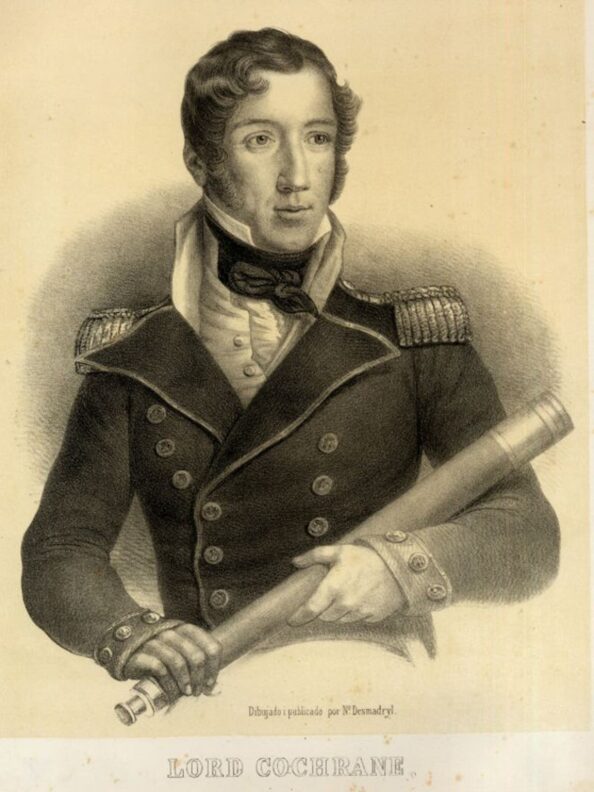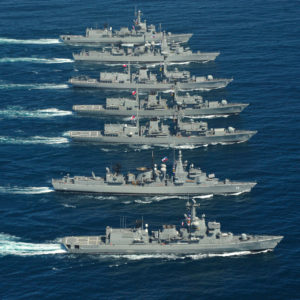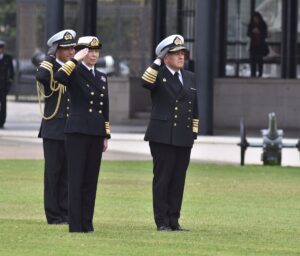
This article publication was permitted by Naval Review editor, Bruce Williams
The Chilean Navy and the Royal Navy have a relationship that is more than 200 years old. It started when Thomas Cochrane arrived in Chile in 1818 to command the recently created fleet and lead it successfully to a victorious start that still governs the culture and ethos of the Chilean Navy. Two centuries after he left, we have three Type 23s and before that we operated Leander-class frigates, County class destroyers and many other vessels of British origin.

Fig 1: VAdm Lord Thomas Cochrane
The question is the future of a relationship that is basically kept alive and nurtured by the navies of two like-minded liberal democracies, but have no common problems to solve, or interests other than their desire for a rules-based world order and a common standing on issues such as global warming and the impacts of climate change. Chile is currently focused in the Pacific and the UK continues to be distracted by Europe in spite of finally moving ahead with Brexit and making public its desire for a more ‘Global Britain’. Understanding that, from a naval perspective, this relationship has been positive for both parties, the key question is what should we do if we want this relationship to survive the lack of common national problems and not be lost because of that?
The first thing is to have a look at the past and understand how we got here. The past goes back 200 years to the arrival of Lord Thomas Cochrane and several of his captains who accompanied him to Chile. He was employed to lead a navy that had only been in existence for a few months.
He was pretty successful as a commander-in-chief and his victories allowed Chile to dominate in the southwestern Pacific and therefore eliminate Spanish presence in South America. From a naval point of view, more important yet is the fact that he left the Chilean Navy with traditions and a culture that are still in-place after two centuries. Having said that, Cochrane and his team allowed a rapid and successful build-up of a navy that not only allowed it to beat the Spanish naval presence, but also allowed it to beat its enemies in all wars it had to participate in the 19th Century. And produce heroes such as Prat and Condell in a navy that was mainly equipped with British made warships and had several officers with English, Scottish, Welsh or Irish surnames like Williams, Lynch, Balaresque, Bannen, Bynon, Charles, Delano, Forster, Hyatt, Mery, Miller, Morris, O’Ryan, O’Brien, Pugh, Reynolds, Simpson, Thompson, Wilkinson, Wilson, Witting and Wood.
The naval link with Great Britain, the main naval power and shipbuilder of the time, was also made possible by the fact that the British community was pretty large and distributed along all the coast of Chile. They worked for British companies, commercial and mining interests established in Chile, so it is not surprising that such a strong relationship was in place for most of the 19th Century and all the way up to the beginning of the Second World War. Also, during that time, the UK was Chile’s main trading partner, a fact that has to be considered when looking at what kept us together for such a long time.

Fig 2: The Chilean battleship Almirante Latorre in 1921 (Super Dreadnought-class built Newcastle upon Tyne in 1915)
The beginning of the 20th Century finds Chile rich because of the earnings the nitrate mines provided. This allowed the Chilean Navy to have a first-class fleet, maybe the most powerful one in the Pacific coast of the Americas. Chile had beaten Perú and Bolivia in a war that took place between 1879 and 1883; thus had no ‘noise’ up north but had an uneasy relationship with the Argentine that more than justified having a powerful navy.
Chile´s luck ended when the nitrate lost its value. That meant that there was no funding for the renewal of its British made fleet, a situation that was made worse by the crisis of the 1930s and that did not change until the end of the WWII, when surplus US made materiel was made available and the fleet renewal started taking place.
During most of the 20th Century British commercial interests in Chile were pretty active but suffered with the nationalisation of banking and mining under the Allende´s government of the early 1970s and that coincided with a loss of global competitiveness of British industry in general. British communities present in Chile continued to be active and had several schools that attracted not only their children, but a good part of the local elite.
The US Navy influence, as would have been expected after WWII, increased across all of South America, but was never that strong and only lasted a couple of decades. Chile ordered two destroyers’ – Almirante-class– from Vickers in the mid 1950s and delivered in 1960. Then at the end of the 1960s ordered two Leander-class frigates and two Oberonclass submarines that arrived in Chile by the mid 1970s. In the 1980s Chile bought from the UK four County-class destroyers, one Tide-class oiler and, at the beginning of the 1990s, two more Leanders that replaced the old US built destroyers. This fleet composed of County-class destroyers and Leanders remained in service up to the mid 2000s. It marked a whole generation of officers and ratings. Some of the purchases were accompanied by training delivered by the world class training provided by FOST that were the foundation for new on-board organisations, a Chilean version of the FOST training organisation and much more use of the RN terms and publications: PWOs, AAWOs and BRs.
One of the things that kept Chile and the UK together during the 1970s and 1980s, and continues to do so today, is the Argentine and its interest on British and Chilean territories and waters. This is maybe the main political reason for the British government to support the very developed naval relationship in times that there were no major commercial interests to take care of or protect. Recent developments in Argentine foreign policy indicate that their claims have increased to cover the extended continental shelf in a way that obviously is very favourable to them and will cause upset to both countries’ claims on the Antarctica, that although they overlap in some parts, can get very messed up with the extended Argentine view of the southern part of the world.

Fig 3: Chilean frigates in formation
Before looking at the current Chilean fleet and its future needs, a key question must be answered and that is why Chile needs a blue water navy and what is the purpose of the Chilean Navy? The Chilean Navy main roles cover both warfighting and constabulary functions. Other roles include supporting Chile´s foreign policy and attending the integration needs of the parts of Chile that are not located in the mainland. The uniqueness and complexity of the Chilean maritime business case that the Chilean Navy has to address is dominated by the following factors:
The constabulary role of the Chilean navy is more complex than most other countries. Not only is the navy is in charge of the policing, but also is the national maritime authority and as such provides all port authorities in Chile. This function is very demanding in resources, but having said that, the Chilean solution of having both main roles under one management allows for synergies and cost efficiencies; consequently it’s not uncommon to find frigates patrolling the EEZ.
The main part of the Chilean design to attend its very special business case is a flotilla of eight frigates, four diesel submarines, three missile boats, two fleet oilers and four OPVs, plus a large assortment of patrol, auxiliary and transport vessels, support aircraft, a Marine Corps brigade and a Special Forces command. These material resources coupled with a fully professional and trained team allow the navy to perform the assigned roles under NATO standards, that with the passing of the years, is including more and more; with the need to cooperate in keeping the oceans open for trade, that as mentioned before, in our case means the Western Pacific. For that reason, it is not strange to see the Chilean Navy working closely with the Australians and other Pacific Ocean navies that share the same preoccupations, that with global competition with China and the US becomes more complex to handle and solve. We can’t anymore depend on the US only to keep the sea lanes open for others to enjoy the benefits. Time has come for all of us to share the costs of doing so.
Another complexity the Chilean Navy has to deal with is that the Chilean seas are pretty rough and any ocean going that takes you far from the coast requires ships with good sea handling capabilities. This requirement leaves out solutions based on missile boats or vessels that do not handle well complicated sea conditions. In this same section, going all the way to Australia or the Malacca Straits require at least frigate sized material.
The fleet of Countys and Leanders was replaced in the mid 2000s by one Type 22 Batch 2, three Type 23s and four former frigates of the Royal Netherlands Navy, and only very recently the replacements included two Australian Adelaide-class frigates – this was a very convenient deal for the Armada, but that was carried out because of the strong friendship with Australia and because no further Type 23s being available, the preferred choice of Chile. The Type 23s are in the process of being modernised and that includes replacing Sea Wolf for Sea Ceptor, improved command and control systems, and sonar technologies. The Type 23s have proved to be excellent platforms for the Chilean seas and so has the Type 22, that was also modernised in Chile and performs as the flagship of the fleet. The purchase of the Type 23s, as in previous purchases, came with FOST provided training that has allowed Chile to operate under NATO standards and take leading roles in the US lead RIMPAC biannual exercise.

Fig 4: The Princess Royal at the Chilean Naval Academy 2018 (www.escuelanaval.cl)
The future renewal of the current fleet is a big issue and something that worries the current Chilean Navy leadership. The idea is to build in Chile the replacement frigates. Chile has a naval construction tradition, including 3 shipyards, and is not new to this type of idea, but its experience is limited to auxiliary vessels and complex midlife submarines overhauls. The type 31s could be a good idea and something that should be explored and that should be a win-win solution for both Chile and the UK, with the design in the hands of BAE and the shipbuilding taking place in the “Talcahuano” ASMAR shipyard. The replacement strategy in a world in which there is nothing much good in the secondhand section, has to be decided soon for 2 reasons, the first is that any shipbuilding effort is expensive, and second, its expensive. In that sense, the recent British experience is being studied and lessons are being incorporated into the Chilean planning. In the short term, a go ahead has been given for local construction of the replacements of auxiliary and transport vessels that will soon reach their maximum operational life.
The 200th anniversary (in 2018) of Cochrane´s arrival in Chile was celebrated in big fashion. The UK delegation included the Princess Royal and 1SL, and was a great opportunity to remember every one of the bonds that had been built during that time and that has to be kept and taken care of. There can always be reasons to let a relationship go under, but our common Argentine problem, the possibility of joining forces in a naval construction plan based on the Type 31 frigates could be good enough reasons; apart of the professional naval links that come by operating the Type 23s and the use of training facilities and education programs in the UK.
Versión PDF
Año CXXXIX, Volumen 142, Número 1004
Enero - Febrero 2025
Inicie sesión con su cuenta de suscriptor para comentar.-